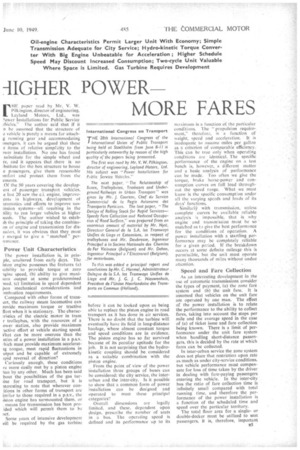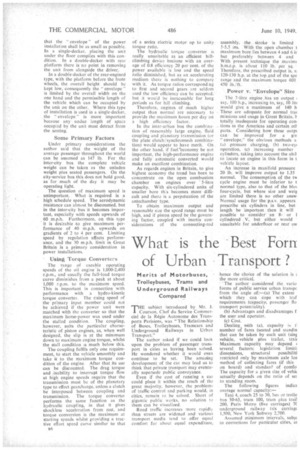- IIGHER POWER
Page 13

Page 14

If you've noticed an error in this article please click here to report it so we can fix it.
MORE FARES
FHP paper read by Mr_ V. W. Pilkington,, director of engineering, Leyland Motors, Ltd., was ?ower Installations for Public Service !hides." The author said that if it n be assumed that the structure of a vehicle is purely a means for attachg running gear and accommodating issengers, it can be argued that these a items of relative simplicity to the iwer installation. No one has found substitute for the simple wheel and re, and it appears that .there is no lostitute for the box structure to house e passengers, give them reasonable
• mfort and protect them from the merits.
Of the 50 years covering the developens of passenger transport vehicles. e last 20 saw the c.i. engine, improveants in highways, development of ieumatics and efforts to iniprove susthsion systems—all resulting in the Ality to Jun larger vehicles at higher leeds. The author wished to estab5li the principle of taking the combina-an of engine and transmission for clisission, it was obvious that they must e merged to give a " matched " .per
nana nee.
Power Unit Characteristics
The power installation is, in prinpie, unaltered from early days. The iston engine possesses the features (a) lability to provide torque at zero igine speed, (b) ability to give maxiaim output at some predetermined seed. (e) limitation in speed dependent on mechanical considerations and 3mbustion requirements.
Compared with other forms of transort, the railway steam locomotive can rovide maximum torque or tractive ltort when it is stationary. The characa-isties of the electric motor in train r trolleybus, with the resources of a ower station, also provide maximum .active effort at vehicle starting speed. Vhat can be more onerous than the uties of a power installation in a p.s.v. 'hid] must provide maximum acceleratig torque, meet rapid fluctuations in utput and be capable of extremely .ipid reversal of direction?
Curiously enough, these conditions re more easily met by a piston engine an by any other. Much has been said bout the possibilities of the gas turine for road transport, but it is iteresting to note that wherever conitions in other forms of transport are imilar to those required in a p.s.v., the iiston engine has surmounted them, or . means for transmission has been proided which will permit them to be net.
Some years of intensive development vill be required by the .gas turbine before it can be looked upon as being able to replace the piston engine in road transport as it has done in air services. There is no doubt that the turbine will eventually have its field in long-distance haulage, where almost constant torque and speed conditions are in evidence. The piston engine has so far survived because of its peculiar aptitude for the job. It is not surprising that the hydrokinetic coupling should be considered as a suitable combination with the piston engine.
From the point of view of the power installation three groups of buses can be considered: the city service, the interurban and the inter-city. Is it possible to show that a common form of power installation can be designed and operated to meet these principal categories?
Overall dimensions are legally limited, and these, dependent upon design. prescribe the number of seats in a bus. The operating speed is defined and its performance up to its
maximum is a function of the particular conditions. The propulsion requirement," therefore, is a function of weight, speed and acceleration. It is inadequate to assume miles per gallon as a criterion of comparable efficiency. This can be true only when operating conditions are identical, The specific, performance of the engine on a test bench is, however, a different matter and a basic analysis of performance can be made. Too often we give the torque, brake horse-power and consumption curves on full load throughout the speed range. Whatwe must know is the specific consumption under all the varying speeds and loads of its days' functions.
Similar' with transmission, unless complete curves be available reliable analysis is impossible, that is why engine and transmission must be so matched as ta give the best performance for ihe conditions of operation. A power installation with a startling performance may be completely reliable for a given period. If the breakdown occurs at some definite mileage this is permissible, but the unit must operate many thousands of miles without undue attention.
Speed and Fare Collection
As an interesting development in the use of automatic transmissions consider the types of payment, (a) the zone fare system and (b) the unit fare. It is assumed that vehicles on the unit fare are operated by one man. The effect of the power installation is to relate the performance to the ability to collect fares, taking into account the stops per mile and the average speed in the case of (a) of ticket issue and fare collection being known. There is a limit of performance under the unit fare system when handling short-distance passengers, this is decided by the rate at which fares can be collected.
In inter-urban service the zone system does not place that restriction upon rate as much as under city-service conditions, but vehicle performance must compensate for loss of time taken by the driver in dealing with fare-paying passengers entering the vehicle. In the inter-city bus the ratio of fare collection time is infinitely small compared with total running time, and therefore the performance of the power installation is a function of the scheduled time and speed over the particular territory. The total floor area for a singleor double-decker must be utilized to seat passengers. it is, therefore, important a5 that the " envelope" of the power installation shall be as small as possible. In a single-decker. placing the unit under the floor complies with this condition. In a double-decker with rear platform there is no point in removing the unit from alongside the driver.
In a double-decker of the rear-engincd -type, with the platform before the front wheels, the overall height should be kept low, consequently the "envelope " is limited by the overall width on the one hand and the permissible length of the vehicle which can be occupied by the unit on the other. Where this type of installation is used in a single-decker, the " envelope" is more important because any undue length of space occupied by the unit must detract from the seating,
Some Primary Factors
Under primary considerations the author said that the weight of the average passenger throughout the world can be assumed as 147 lb. For the inter-city bus the complete vehicle weight can be taken as the unladen weight plus seated passengers. On the city-service bus this does not hold good, as for much of the day it may be operating light.
The question of maximum speed is unimportant. What is required is a high schedule speed. The aerodynamic resistance can almost be discounted, but in the inter-city bus it becomes important, especially with speeds upwards of 60 m.p.h. Furthermore, on this type it is desirable 40 give maximum performance of 40 m.p.h. upwards on gradients of 2 to 4 per cent. Limiting speed by regulation affects performance, arid the 30 m.p.h. limit in Great Britain is a primary consideration in power installations.
" Using Torque Converters The range of useable operating speeds of the oil engine is 1,000-2,400 r.p.m., and usually the full-load torque curve diminishes from a peak at about 1,000 r.p.m. to the maximum speed. This is important in connection with performance with a hydro-kinetic torque converter. The rising speed of the primary input member could not be achieved if the power unit were matched with the converter so that the maximum Inn-se-power was used under the stalled condition. The coupling, however, suits the particular characteristic of piston engines, as, when well designed, the slip is at the minimum down to maximum engine torque, whilst the stall condition is much below this.
The coupling fulfils only one requirement, to start the vehicle smoothly and take it to the maximum torque condition of the engine. After that its use can be discounted. The drag torque and ,inability to interrupt torque flow at high engine speeds require that the transmission must be of the planetary type to effect gearchange, unless a clutch be interposed between coupling and transmission. The torque converter performs the same function as the hydraulic coupling, in that it gives shockless acceleration from rest, and torque conversion is the maximum at starting speeds whilst providing a tractive effort speed curve similar to that 136 of a series electric motor up to unity torque ratio.
The hydraulic torque cooverter is really unsuitable as an efficient hillclimbing device because with an average of 0.8 efficiency. 20 per cent, of the power available 'is lost and the speed ratio diminished, but as an accelerating medium there is nothine to compare with it. As torque ratios corresporidMg to first and second gears are seldom used the low efficiency can be accepted, but it would be inexcusable ler long periods as for hill climbing.
Therefore, engines of much higher output than nonnal are necessary to provide the maximum hours per day on a high efficiency factor.
In the inter-urban bus the combination of reasonably large engine, fluid coupling and planetary transmission (or the plate clutch/synchromesh cornbination) would appear to have Merit. On the other hand, if fuelseconomy be not important, the high-performance engine and fully automatic convertedwould make an excellent combination.
As regards engines in Britain, to give highest economy the trend has been to concentrate on the open combustion chamber on engines over ' 5-litre capacity. With six-cylindered units of smaller bore this becomes more difficult and there is a perpetuation of the antechamber type.
To obtain maximum output and reasonable size the speed range must be high, and if piston speed be the governing factor, coupled with inertia considerations of the connecting-rod
assembly, the • stroke islimited 5-5.5 ins. With -the alien chamber t maximum bore lies between 4 and 6 it but preferably between 4 and With present technique the maximi b.m.e.p. is about Il0 lb. per Sq. Therefore, the prescribed output is, s: 120-130 h.p. at the top end of the spe range and the maximum torque 401.1 450 lb./ft.
-.Power v. "Envelope" Size The 7-litre engine has an output I say, 100 h.p., increasing to, Say, 10 lin would give a maximum of 140 h These are adequate for normal tier( missions and usage in Great Britain, h totally, inadequatefor operating core tions in the Americas and certain oth parts. Considering how these outm can be improved for a giv "envelope,' the obvious methods a; (a) pressure charging, (b) two-c4 operation, (c) increasing number cylinders, taking into account the abil to locate an engine in this form in t 'vehicle layout. •
An increase in manifold pressure 20 lb. will improve output to 1.35 normal. The consumption of the tw cycle engine must be inferior to I normal type, also to that of the blol four-cycle, but where size and weig are limited there is no other answ Normal usage for the. p.s.v. appears prescribe six cylinders in line, but length be important then it will possible to consider an 8or cylindered . V, but either would • unsuitable for underfloor or rear ust


























